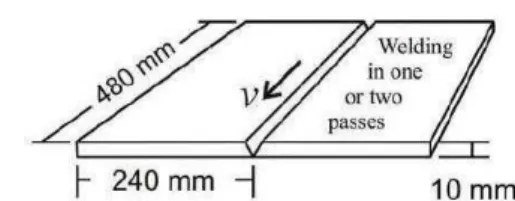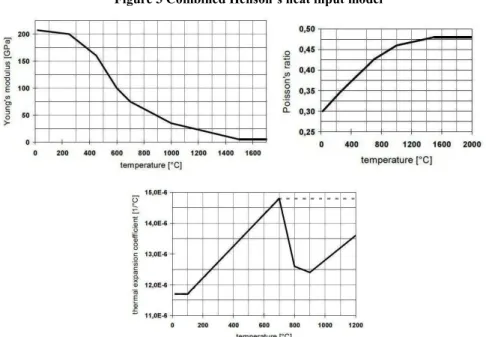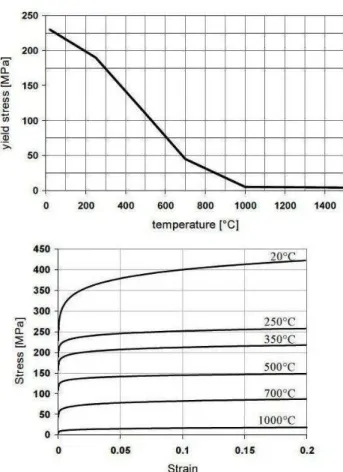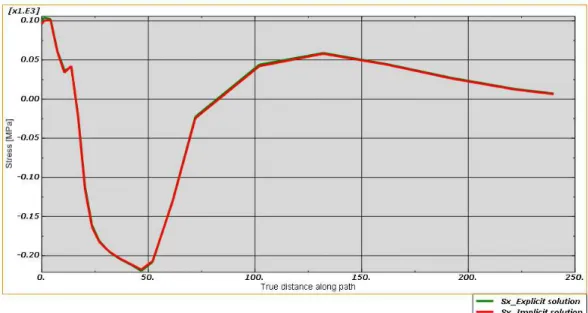NUMERICAL ASPECTS FOR EFFICIENT WELDING
COMPUTATIONAL MECHANICS
by
Tarek Kh.S. ABURUGAa, Aleksandar S. SEDMAKa and Zoran J. RADAKOVICa,
aFaculty of Mechanical Engineering, University of Belgrade, Belgrade, Serbia
Original scientific paper DOI: 10.2298/TSCI130227180A
The effect of the residual stresses and strains is one of the most important parame-ter in the structure integrity assessment. A finite element model is constructed in order to simulate the multi passes mismatched submerged arc welding SAW which used in the welded tensile test specimen. Sequentially coupled thermal mechanical analysis is done by using ABAQUS software for calculating the residual stresses and distortion due to welding. In this work, three main issues were studied in order to reduce the time consuming during welding simulation which is the major problem in the computational welding mechanics (CWM). The first issue is dimen-sionality of the problem. Both two- and three-dimensional models are constructed for the same analysis type, shell element for two dimension simulation shows good performance comparing with brick element. The conventional method to calculate residual stress is by using implicit scheme that because of the welding and cooling time is relatively high. In this work, the author shows that it could use the explicit scheme with the mass scaling technique, and time consuming during the analysis will be reduced very efficiently. By using this new technique, it will be possible to simulate relatively large three dimensional structures.
Key words: efficient welding, thermal analysis, mechanical analysis
Introduction
The welding process is considered as one the most important methods of the joining metals which is the most essential part in the engineering industries. Welding is defined by the American Welding Society (AWS) as a localized coalescence of metals or non-metals produced by either heating of the materials to a suitable temperature with or without the application of pressure, or by the application of pressure alone, with or without the use of filler metal [1]. There are many side effects during this process, the temperature changes in the alloy produce solid state transformations, and this change in the solid transformations will lead to changes in the material properties during the evolution of the process. These changes in the material properties within the heating and the cooling stages induce localized volumetric changes. The inhomogeneous elasto-plastic thermal strains will develop in the vicinity of the welding zone. The residual stresses as a result of the thermal strain will cause permanent distortions. Distortions introduce residual deformation that complicates the assembly of welded structures and reduces their quality. Also, in certain applications, this distortion may result in the structure being useless [1].
Theoretical background
Thermal analysis:
The governing equation for the three dimension conduction heat transfer according to
Fourier’s law:
2 2 2
2 2 2
T T T
k Q cT
x y z
(1)
Where T is temperature, thermal conductivity, Q Rate of internal heat generation, density, specific heat. Thermal boundary conditions are heat loss due to convection, taken into account using Newton’s law:
0
0
c c s c c s
q h T T q h T T
where hc is the heat transfer coefficient, Ts is the surface temperature and T0 is the ambient temperature, as well as heat loss due to radiation, modeled using Stefan–Boltzman law:
4
4273.15 273.15
r s s
q T T
where, is the emissivity, and is the Stefan–Boltzman constant.
The moving heat source is treated as a body heat flux with uniform density instead of thermal boundary conditions [[2]-7].
Mechanical analysis
For three-dimension brick element
The governing differential equation for three dimension mechanical problem
xy xx xz x σ σ σ f 0
x y z
yx yy yz
y
σ σ σ
f 0
x y z
zy zx zz z σ σ σ f 0
x y z
(2)
For two-dimension plate element
The governing differential equation for two dimension mechanical problem
4 4 4
4 2 2 2 4
w w w p
D
x x y y
(3)
The input data
The work of Henson [08] will be used as reference in order to validate the
numerical simulations with the experimental results of Henson’s work. Therefore, the same
Figure 1 Thermal conductivity, Heat capacity, and Density vs. temperature
Thermal Properties
In order to analyze the transient energy distribution, the thermal conductivity, specific heat, and mass density (Figure 1) must be specified. If the heat source is able to make phase transformations the latent heat must be considered. Because of the nature of the welding process, these properties should be given as a function of temperature changes. For the latent heat both solid-liquid and liquid-gas phase changes are considered in this study. The numerical values of these quantities for the steel are shown in
Table 1.
Figure 2 Thermal conductivity, Heat capacity, and density vs. temperature
Table 1 Latent heat values for the steel
TSolid=TA C° TLiquid=TB C° qAB KJ TLiquid=TDC° TGas=TE C° qDEKJ
1490 1540 272.1 2400 2450 6456
Welding Parameters:
The welding parameters for this model are as used in Henson’s work. These
Table 2 Welding parameters
η (-) I (Amp) U(Voltage) V(mm/s) Q(KJ/mm)
.98 530 27.2 4.57 3.1
Heat input Model:
For submerged arc welding, Henson use heat input mode, where the heat input due to the arc was split into three parts:
1) Predefined temperature for the welded material, 2) Surface heat flux,
3) Body heat flux.
In this work, this model will be used because it is validated by the experiment, and because it has detailed description for the heat flux, and finally it simple to apply in the finite element codes [9]. Figure 3 shows this heat input model.
Mechanical properties:
For the structural analysis, the following mechanical properties must be specified. The yield strength curves as a function of temperature and strains is shown in Fig. 4, whereas
modules of elasticity, Poisson’s ratio, and thermal expansion are given in Figure 4, 5.
Figure 3 Combined Henson’s heat input model
Figure 5 Yield stresses vs. temperature and strains
Problem’s Dimensionality Effect
In order to reduce the time consuming of the simulation, the three dimension problem could be reduced to two dimension one. Shell element model is used to simulate the problem.
Problem’s Dimensionality Effect in the Thermal Analysis
By using the shell element in thermal analysis, the simulation is successfully done with good agreement as shown in [10]. For the problems that does not need very accurate results such that where the residual stresses only are needed, two dimension simulation is a practical one especially for the large structures and multi runs welding.
Problem’s Dimensionality Effect in the Mechanical Analysis
Figure 6. The equivalent (Mises) residual stress for 3D and 2D models
Figure 7. The longitudinal residual stress x for 3D and 2D models
Figure 8. The transverse residual stress yfor 3D and 2D models
Figure 10. The equivalent residual plastic strain for 3D and 2D models
The normal and shear strains are shown in Figure 11 for the longitudinal residual plastic strain, in Figure 12 for the transverse residual plastic strain, and in Figure 13 for the shear residual plastic strain.
Figure 11. The longitudinal residual plastic strain pεx for 3D and 2D models
Figure 12. The transverse residual plastic strain pεy for 3D and 2D models
Integration Scheme Effect in the Mechanical Analysis
In some cases like welding the stable time will be very small which will lead to very long time simulation, but, by using mass scaling technique this problem will be eliminated [9]. In the welding simulation, a quasi-static mechanical analysis is sufficient as the inertia effects in fusion welding processes are negligible as the weld pool is simplified considerably. Therefore, the mass scaling factor could be very high. In this study, the scaling factor was 107; the accuracy of the result was good as shown in Figure 14 for the equivalent (Mises) residual stress, 15 for the longitudinal residual stress, and Figure 16. for the transverse residual stress.
Figure 14. The equivalent stress for implicit and explicit models at the end of welding stage
Figure 15. The longitudinal stress x for implicit and explicit models at the end of welding stage
Figure 16. The transverse stress y for implicit and explicit models at the end of welding stage
Figure 17. Comparison between explicit and implicit solutions
Conclusions
In the present work, finite element models have been used to analyze the thermal and mechanical phenomena observed in welding processes. Thermal histories and residual stresses have been predicted.
The main problem in computational welding mechanics (CWM) is the time consuming during the analysis. Different methods are used in this work in order to reduce time consuming. These methods are according to the dimensionality of the problem and the integration scheme.
The one of research issue of central importance in developing the numerical approach is how to reduce time consuming. This work shows that it is possible to used two dimension shell element instead of three dimensional one with reasonable accuracy. There is some limitations in this method, it is not practical where the very accurate result is needed such in weld pool studies, and it is depend on the structure itself if it is plate or shell one or not.
The second approach is by using explicit scheme instead of implicit scheme. This approach is very efficient one. By using mass scaling technique, it is possible to reduce the time consuming during the analysis by several orders in some cases.
References
[1] Andres Anca, Alberto Cardona, Jose Risso, Victor D. Fachinotti,” Finite element modeling of
welding processes”,Applied Mathematical Modelling 35 (2011) 2, pp. 688–707
[2] S.W. Wen,P.Hilton,D.C.J. Farrugia, ,” Finite element modeling of a submerged arc welding
process”,Journal of Material Processing Technology 119 (2001) 1-3, pp. 203–209
[4] M. Berkovic, S. Maksimovic and A. Sedmak, "Analysis of Welded Joints by Applying the Finite Element Method," Structural Integrity and Life, vol. 4, no. 2, pp. 75-83, 2004.
[5] V. N. Lazic, A. S. Sedmak, M. M. Zivkovic, S. M. Aleksandrovic, R. D. Cukic, R. D. Jovicic and I. B. Ivanovic, "Determining Of Cooling Time (t8/5) In Hard Facing Of Steels For Forging Dies," Thermal science, vol. 14, no. 1, pp. 235-246, 2010.
[6] S. Cvetkovski, L. P. Karjalainen, V. Kujanpaa and A. Ahmad, "Welding Heat Input Determination In TIG And Laser Welding of Ldx 2101 Steel by Implementing The Adams Equation For 2-D Heat Distribution," Structural Integrity and Life, vol. 10, no. 2, pp. 103-109, 2010.
[7] Veljić, M. Perović, A. Sedmak, M. Rakin, N. Bajić, B. Medjo, H. Dascau, Numerical Simulation of the Plunge Stage in Friction Stir Welding, Structural Integrity and Life, Vol.11, No. 2, 2011, pp.131-134
[8] J. Hansen, “Numerical modeling of welding induced stresses”, Department of Manufacturing Engineering and Management, Technical University of Denmark, 2003.
[9] ABAQUS/Standard user manual version 6.10, Hibbit, Karlsson, and Soresen, Inc., 2010
[10] Tarek Aburuga, Ph.D. thesis, Temperature fields and residual stresses in welded joints of high-strength steel, Faculty of Mechanical Engineering, University of Belgrade, 2014






